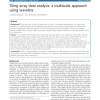Free Online Productivity Tools
i2Speak
i2Symbol
i2OCR
iTex2Img
iWeb2Print
iWeb2Shot
i2Type
iPdf2Split
iPdf2Merge
i2Bopomofo
i2Arabic
i2Style
i2Image
i2PDF
iLatex2Rtf
Sci2ools
BMCBI
2011
2011
Tiling array data analysis: a multiscale approach using wavelets
Background: Tiling array data is hard to interpret due to noise. The wavelet transformation is a widely used technique in signal processing for elucidating the true signal from noisy data. Consequently, we attempted to denoise representative tiling array datasets for ChIP-chip experiments using wavelets. In doing this, we used specific wavelet basis functions, Coiflets, since their triangular shape closely resembles the expected profiles of true ChIP-chip peaks. Results: In our wavelet-transformed data, we observed that noise tends to be confined to small scales while the useful signal-of-interest spans multiple large scales. We were also able to show that wavelet coefficients due to non-specific cross-hybridization follow a log-normal distribution, and we used this fact in developing a thresholding procedure. In particular, wavelets allow one to set an unambiguous, absolute threshold, which has been hard to define in ChIP-chip experiments. One can set this threshold by requiring a si...
| Added | 12 May 2011 |
| Updated | 12 May 2011 |
| Type | Journal |
| Year | 2011 |
| Where | BMCBI |
| Authors | Alexander Karpikov, Joel S. Rozowsky, Mark Gerstein |
Comments (0)

